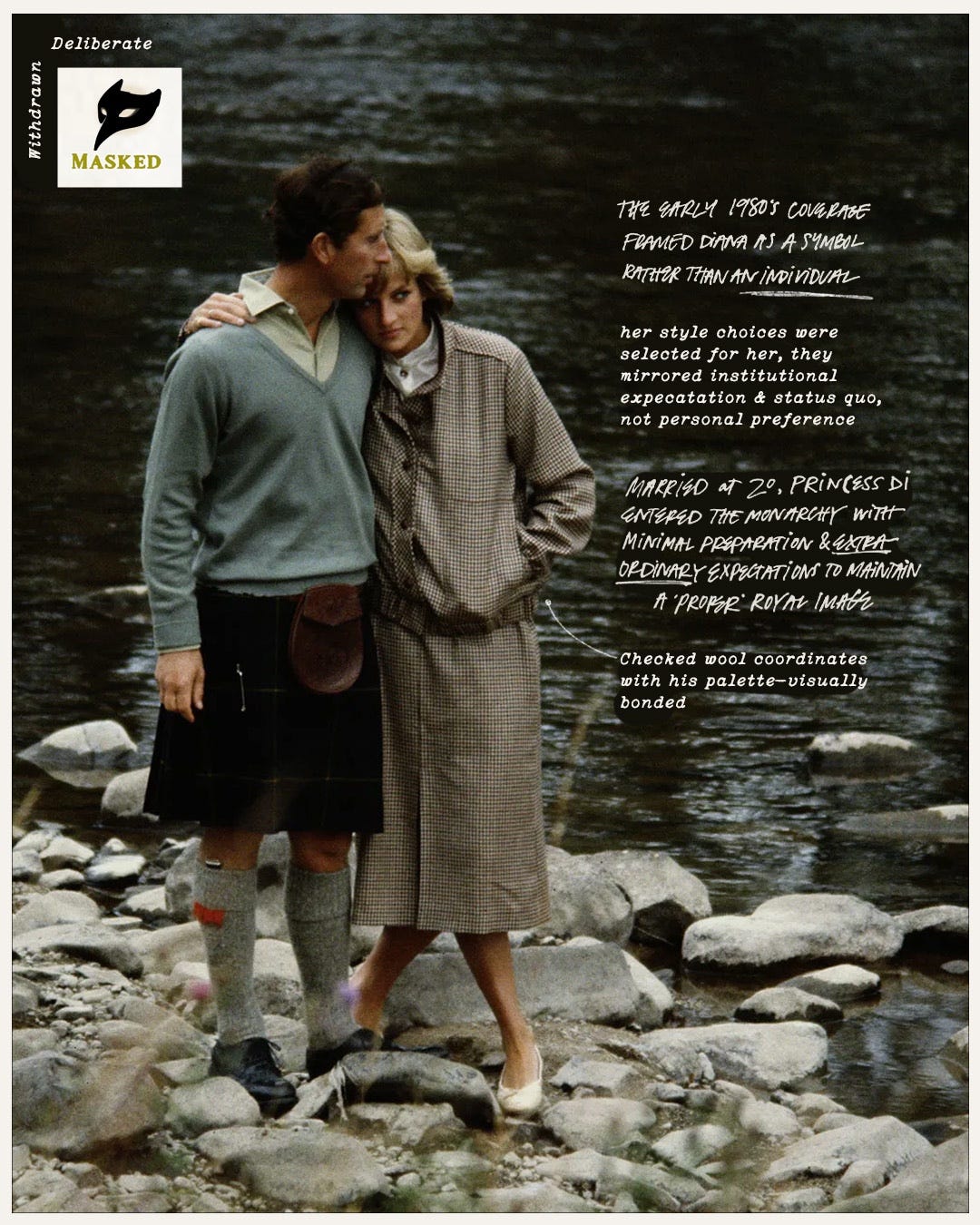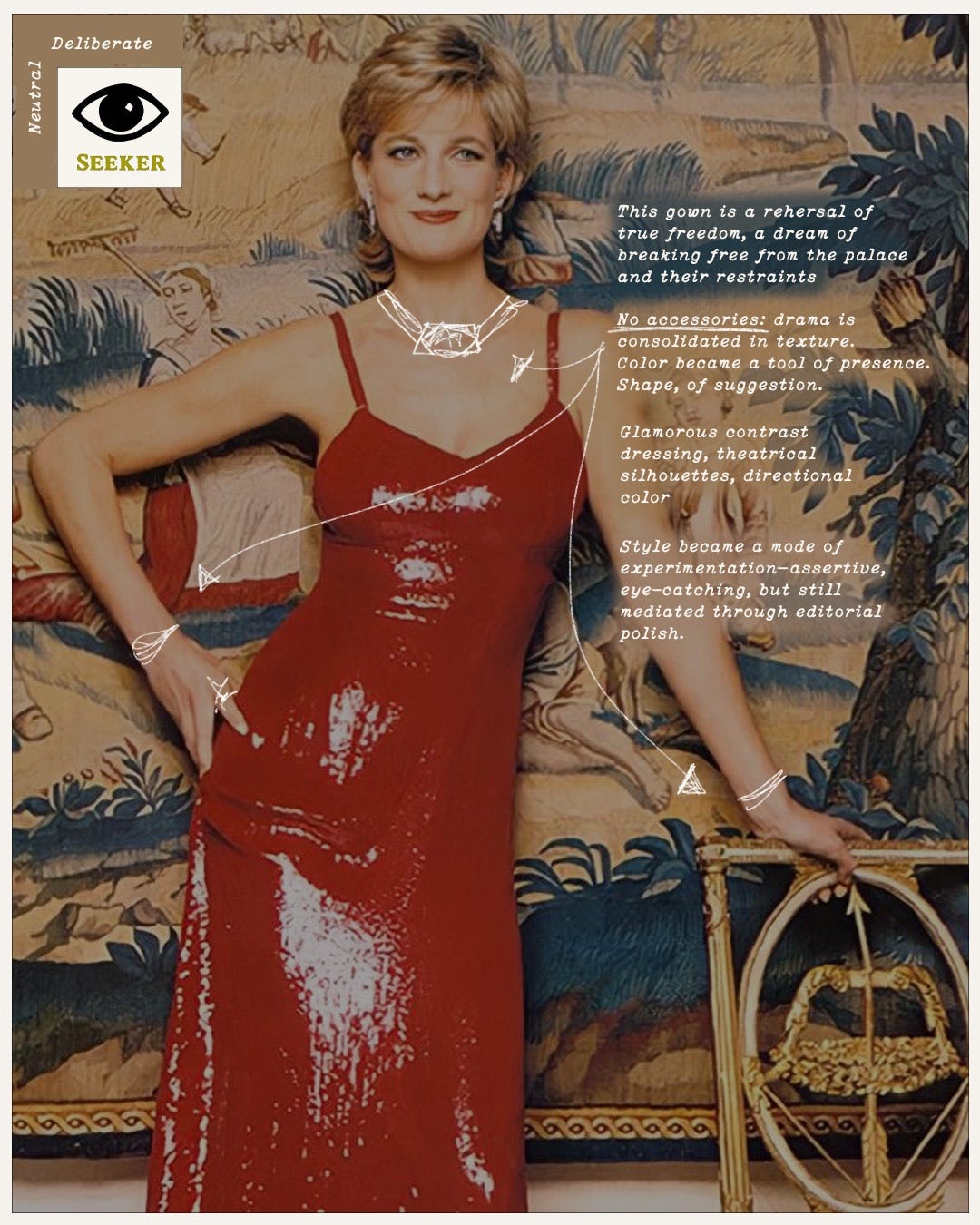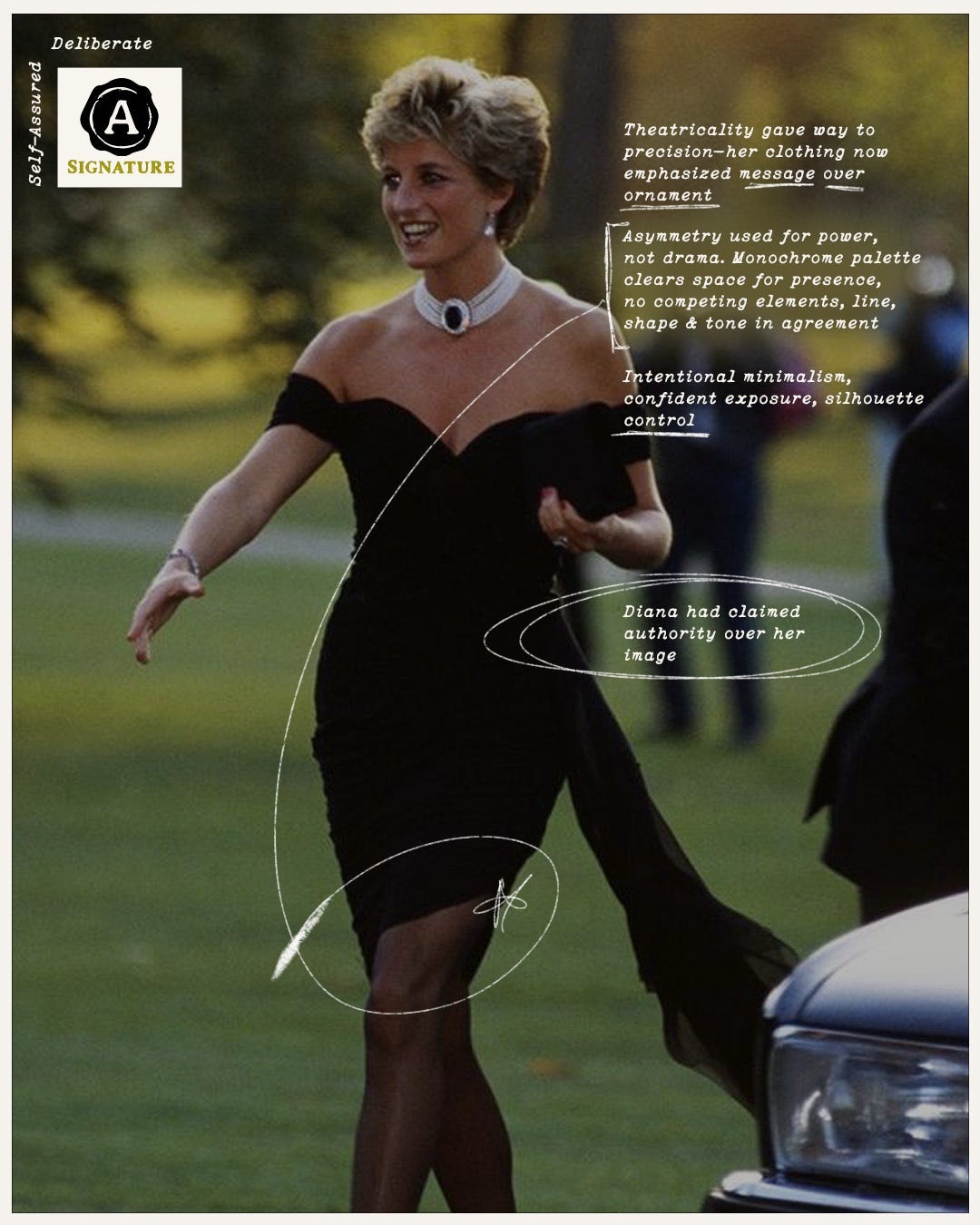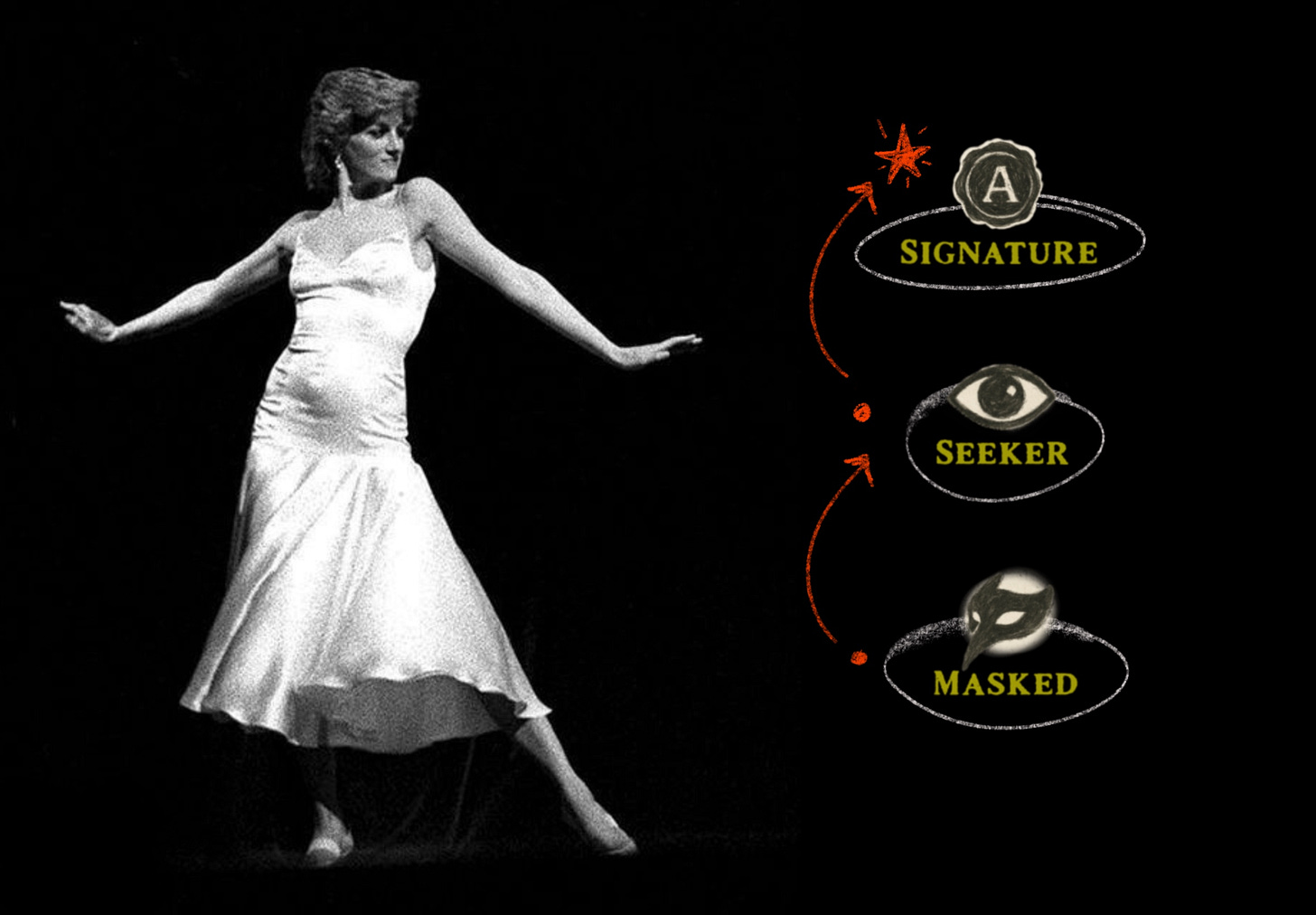Princess Diana and the Evidence of Style
Mapped through The Masked, The Seeker, and The Signature
Style as Evidence: Case studies in aesthetic evolution and psychological alignment, interpreted through the Style Alignment Chart.
Our style isn’t our identity. Our style is how we shape our identity.
Our appearance becomes behavior, and our behavior becomes self. Therefore, style is not metaphorical. It’s behavioral.
That’s the foundation of the Style Alignment Chart: a diagnostic framework made up of nine archetypes, each showing how your internal state is expressing itself outwardly—through posture, presence, and appearance.
This chart doesn’t measure taste or personality. It’s not about what you like, it’s about how you show up. The archetypes aren’t fixed types or moral categories. They’re reflections of how deliberate you are, and how connected you feel to yourself. Think of them as shifting states of engagements: You are not just one of these. You may shift based on environment, move up or down with mood or energy, or currently occupy one square as you reach for another.
Princess Diana’s style has captivated the world for over three decades. She remains the most photographed woman in modern history, as close to an eternal being as humanly possible. She captivates us not just because she was a royal, but because of her emotional journey. She made it visible, we saw her grow, we watched her change. Her greatest moments in style weren’t simply about clothing. She evolved into herself, yet she was fully herself in every phase.
This is not a fashion retrospective.
It’s a study in alignment: the shift from performance to possession.
Phase 1: The Masked
(Deliberate + Withdrawn)
Presentation as protection.
Married at just 20, with an audience of 750 million watching, Diana didn’t dress to express herself. She dressed to embody a role. That role was the monarchy—an institution that leaves little room for individuality and demands total adherence to visual code. Her style in those early years was steeped in bows, high collars, pastels. She was pristine and contained, styled almost entirely by palace-appointed dressers.
Her appearances were tightly choreographed to meet royal expectations: heritage prints, demure silhouettes, and color palettes selected more for cultural symbolism than personal taste. She wasn’t meant to stand out. She was meant to belong. The precision wasn’t aesthetic, it was strategic, and she and Charles always looked just right together. Her wardrobe matched the scenery, was perfectly calibrated to present a united front.
Her body language followed suit, tilted head, clasped hands, the quiet posture of someone trying to stay within the lines. She looked immaculate. Unthreatening. Perfect. She was an emblem, not an individual.
Phase 2: The Seeker
(Deliberate + Neutral)
Presentation as inquiry.
Midway through her public life, the performance began to fracture. Diana started testing the edges of her role, sometimes subtly, sometimes brazenly. She began trading peter pan collars for sharp-cut skirt suits. Pastels gave way to dark sapphires and emeralds. This was the era of her now-iconic athleisure: cycling in spandex, leaving clubs in sweatshirts and pullovers, pairing riding boots with jeans. What looked like everyday clothing signaled something deeper, a deliberate visual departure.
By this point, she and Charles were functionally separated. Free from the tight grip of palace protocol, Diana began working with stylists outside royal approval. Her wardrobe became more personal, more unpredictable. She oscillated between statement gowns and off-duty casuals, revealing a style no longer tethered to a single directive. One moment, ultra-feminine glamour; the next, pragmatic realism.
This is where the Seeker lives: caught between who they’ve been and who they might become. Style became a space for contradiction, confidence beside constraint, glamour beside rebellion. Diana was no longer trying to play the part. She was trying things on.
And during this stretch of transformation, her appearance stopped asking “Do you approve?”
and started asking “Do I?”
Phase 3: The Signature
(Deliberate + Self-Assured)
Presentation as clarity.
In her final years, Diana’s style became unmistakable.
Monochrome tailoring, minimalist column gowns, and clean, assertive silhouettes replaced the ornamental codes of duty. The days of dressing for expectation were gone. Her wardrobe distilled into a personal vocabulary, feminine, focused, and effortlessly self-assured. She wore pink Converse to examine land mines. She wore Versace on errands. She had nothing to prove.
And then, The Revenge Dress.
On the night Prince Charles admitted to the world on live television that he had been unfaithful, Diana stepped out of a sleek black car, smiling broadly, making the most powerful nonverbal statement of her life. This dress, this off-the-shoulder, above the knee, wickedly form-fitting vision violated every rule of royal protocol. Black was reserved for mourning. Bare shoulders were forbidden. Hemlines were meant to fall below the knee. But Diana didn’t flinch. She didn’t explain. She simply arrived.
What I adore most about this, is that this wasnt a dress she bought for the…occasion. Diana had owned this dress for years, always pushing it to the back of her closet, never drumming up the courage to wear something so bold. This night, however, she made a statement without saying any words at all. She was the punctuation on an already broken sentence, and when the world saw her that night, they fell in love all over again.
Because in a single moment, we saw her for exactly who she was. Diana, The People’s Princess, was not a woman scorned. She was a woman defined by no one. She didn’t need anyone to complete her, she did that, all by herself.
She no longer dressed to adapt or disrupt, she dressed to inhabit.
The Transformation
The Masked → The Seeker → The Signature
Deliberate + Withdrawn → Deliberate + Neutral → Deliberate + Self-Assured
Diana didn’t just discover herself one day, with a collection of purchases or new stylists. She moved through a series of emotional thresholds that gave her access to new levels of her identity. First, she preformed, then she questioned, and finally, she reclaimed.
This is the work of alignment: not finding the right outfit, but finding the version of yourself who no longer needs to be styled into existence. Who we think we are, is who we design ourselves to be. Your style is a self-fulfilling prophecy.
What made Diana iconic wasn’t just her fashion. It was her clarity.
She showed us what it looks like to take full ownership of who you are. What it looked like to begin with a borrowed identity, and morph into something entirely her own. Her style is the visual evidence of her reclamation, and without question, the reason why we still feel so connected to her, to this day.
This is the power of personal style.
So, the question isn’t what are you wearing, but rather, do you know why you’re wearing it?
With great personal aesthetic,
Alexandra Diana, The A List







